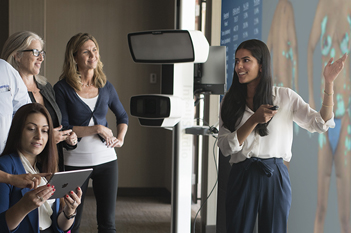“VECTRA 3D imagery makes patients much more comfortable with their decision to proceed with surgery and gives me a better sense of what’s going to work before surgery so the patient spends less time in surgery. I use the VISIA surface and subsurface imaging for the skin care portion of my practice to educate patients on the overall health of their skin and track their improvements with treatment.

- Isaac Starker, MD, FACS
- The Peer Group
- Florham Park New Jersey
Dr. Isaac Starker’s surgical philosophy is based upon the premise that successful plastic surgery is an open and honest collaboration between the patient and surgeon. Performing the full range of cosmetic and reconstructive procedures for face and body, Dr. Starker knows the value of advanced imaging before, during and after treatment. He employs VECTRA 3-D imaging, VISIA surface and subsurface images and MIRROR image management software in his practice to educate, document and communicate with his patients, “Before 3-D imaging there was no visual you could provide a patient that would show them what they would really look like after a procedure. You could try to simulate with 2-D images, but it’s very different from someone actually looking at themselves in 3-D and understanding what those changes would be like on their own body.”
Dr. Starker was motivated to employ VECTRA as an integral part of his practice to give patients more realistic expectations of what they could achieve with surgery. “I use the images in the course of patient consultations to both assess which changes were desirable to a patient and also determine whether these changes could reasonably be achieved, given their underlying anatomy.” Having better communication between doctor and patient helps patients both before and after a procedure. “Patients are more comfortable before a procedure because they know what to expect. When the results match what the patient was expecting and hoping for, you have a happy patient at the end of the day.” Dr. Starker has even credited the VECTRA images with making his surgeries shorter, “Because we’ve communicated well before surgery I have a better idea of what will work, and it makes for a more predictable, shorter operation.”
In the skin care portion of his practice, Dr. Starker relies on the surface and subsurface images obtained from VISIA to not only track a patient’s progress on a particular regimen but also to show what is invisible to the eye. “I use VISIA to document improvements we’ve achieved with facial lasers and educate a patient on the health of their skin. Even if a patient can’t see the damage you can show them some of the subsurface damage they have and frequently it means that they end up taking much better care of their skin and wearing sunscreen as a result.”
Dr. Isaac Starker is a board-certified cosmetic and reconstructive surgeon in private practice with The Peer Group in Florham Park, NJ. A Fellow of the American College of Surgeons, Dr. Starker earned his undergraduate and medical degrees from New York University, and completed his general surgery training at St. Luke’s – Roosevelt Hospital. His plastic surgery residency was fulfilled at Montefiore Medical Center, the University Hospital for Albert Einstein College of Medicine. He has provided life-altering reconstructive surgery to children in Kenya, El Salvador, Ecuador, and Thailand as a team member with Healing the Children. Dr. Starker has been voted Top Doctor, by NJ Monthly for the past 10 years, an honor bestowed upon him by his peers.
More Doctor Testimonials
- William P. Adams Jr., MD
- Gene Alford, MD, FACS
- Brad Bengtson, MD
- Michael A. Bogdan, MD, FACS
- Gary D. Breslow, MD, FACS
- Mitchell Brown, MD, MEd, FRCSC
- Brentley A. Buchele, MD, MBA
- Louis P. Bucky, MD, FACS
- Timothy Connall, MD, FACS
- Mark D. Epstein, MD, FACS
- Gary Tuma, MD, FACS
- Stephan Finical, MD, FACS
- Allen Gabriel, MD, FACS
- Caroline A. Glicksman, MD, FACS
- Monte O. Harris, MD
- J. David Holcomb, MD
- Farid Kazem, MD
- Anand Kumar, MD, FACS, FAAP
- Prof. Dr. Josep Malvehy
- Patricia McGuire, MD
- Tiago Baptista Fernandes, MD
- Mathew Mosher, MD
- Laxmeesh Mike Nayak, MD
- Dr. Patricia Ogilvie
- Kristina O'Shaughnessy, MD
- Paul M. Parker, MD, FACS
- Steven Pearlman, MD, FACS
- Allen Rosen, MD
- Marc J. Salzman, MD, FACS
- Terrence Scamp, MBBS, FRACS
- Clark Schierle, MD, PhD, FACS
- Michael R. Schwartz, MD, FACS
- Kenneth A. Smith, MD, FRCSC
- Christine Stiles, MD
- Oren Tepper, MD
- Jennifer L. Walden, MD, FACS
- Simeon Wall, Jr., MD, FACS
- Robert Zubowski, MD
